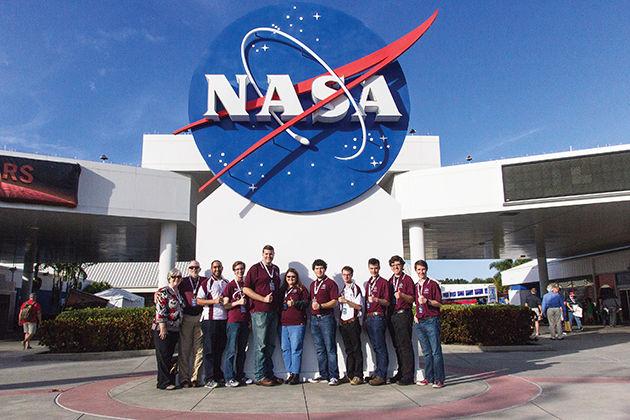A year-long project by Texas A&M students to control a satellite in Earth’s orbit will edge towards completion early Wednesday, as astronauts aboard the International Space Station begin unpacking and assembling “AggieSat4.”
AggieSat4, a student-built miniature satellite, was designed to demonstrate autonomous rendezvous and docking capabilities. It has an unlikely bedfellow aboard the ISS — Bevo-2, a cubesat designed by a team from the University of Texas that will launch from AggieSat4 once the pair is in an independent orbit. The two spacecraft launched Dec. 6 to the ISS as stowaways aboard an Atlas V rocket resupply mission.
Helen Reed, aerospace professor and director of the AggieSat Lab, said the student-built satellite will be released from the ISS on Friday. Reed and a team of A&M students departed from Texas A&M Tuesday night for the Lyndon B. Johnson Space Center in Houston, where they will work with NASA’s Mission Control Center and the astronauts in orbit to properly prepare the satellite.
“The ISS crew will remove AggieSat4 from its foam enclosure that protected it during the launch of OA-4,” Reed said. “Working through a set of written, pre-approved procedures step-by-step, communicating with our team at Mission Control at NASA JSC, the ISS crew will affix antennas, remove solar panel covers, uncover sensors and attach AggieSat4 to a release mechanism called Cyclops.”
Once released, Bevo-2 will separate from AggieSat4, and the two spacecraft will attempt to share data and calculate navigational solutions between their two locations.
Mitchel McDonald, aerospace engineering senior and attitude determination and control system lead, said the astronauts have to do several tasks to prepare AggieSat4 for its journey. Solar panel covers need to be removed, and the satellite must be installed on the Cyclops release mechanism, which will deploy it outside ISS.
“Once the satellite is deployed, it will go through an automatic startup sequence that checks out all of the systems aboard the satellite, and once this is done it will begin sending a signal down to Earth, indicating that it is alive and well,” McDonald said.
McDonald said after deployment, the AggieSat team must wait 31 days — and receive NASA’s permission — before Bevo-2 is launched. The team will have plenty to do for that month however, as AggieSat4 will relay streams of data from orbit to College Station about its status.
“Between [Bevo-2’s release] and now, we’ll be going through all the data that AggieSat4 will be sending down to us and ensuring everything is working flawlessly before the Bevo-2 release,” McDonald said.
Aggie-built satellite to be assembled on ISS
January 27, 2016
Photo by PROVIDED
Astronauts will begin unpacking and assembling the AggieSat4 Wednesday, which will be released from the ISS on Friday.
0
Donate to The Battalion
$2165
$5000
Contributed
Our Goal
Your donation will support the student journalists of Texas A&M University - College Station. Your contribution will allow us to purchase equipment and cover our annual website hosting costs, in addition to paying freelance staffers for their work, travel costs for coverage and more!
More to Discover










